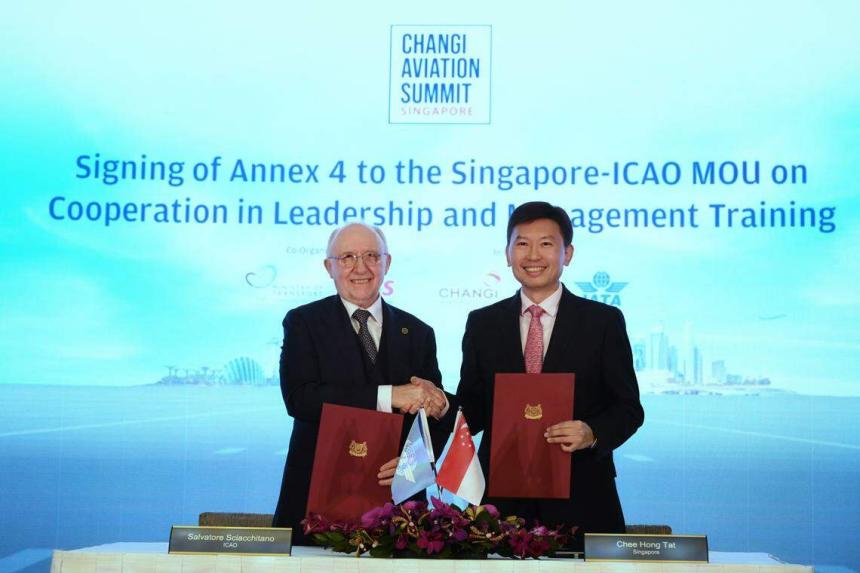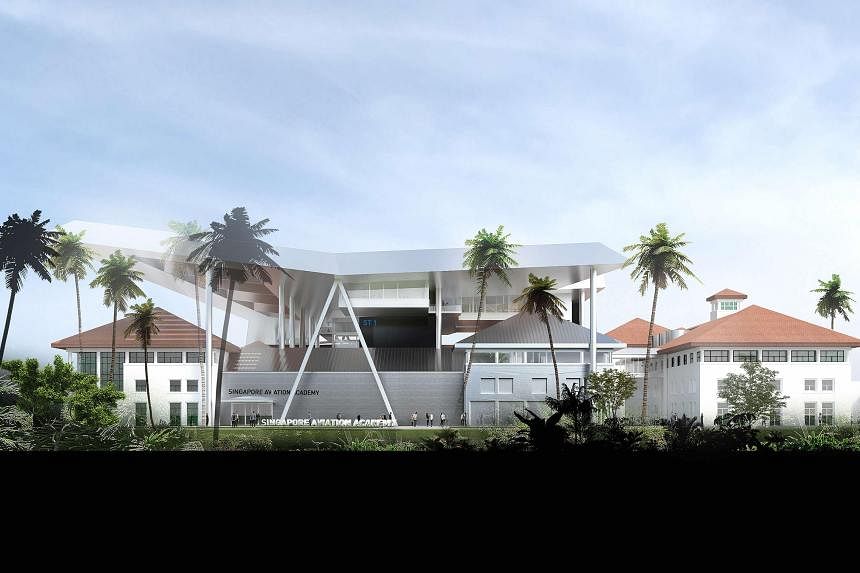SINGAPORE – The Singapore Aviation Academy, the training arm of the Civil Aviation Authority of Singapore (CAAS), will undergo a $120 million refresh to boost the manpower needs of the aviation sector in Singapore and beyond.
Starting in April 2024, the facelift will increase the academy’s training capacity by 20 per cent when it is completed in 2026, said CAAS.
It added that the upgrade will help build the manpower capacity needed to complement the upcoming Terminal 5, which will increase Changi Airport’s handling capacity by 50 million passengers when it is operational in the mid-2030s.
The upgrade will include the addition of a fourth storey near the front of the building, bringing the academy’s total gross floor area of training spaces up from around 2,946 sq m, or almost two-fifths of a football field, to 3,567 sq m, or half a football field.
After the upgrade, the academy will – for the first time – have new spaces open to members of the public, including a rooftop terrace, restaurant and a public events hall. The building will also house a public aviation gallery that will allow visitors to discover the nation’s aviation history and plans, added CAAS.

The academy will also refresh its curriculum progressively from April, via a revamp of its selection of 110 training programmes.
The curriculum refresh will also take into account findings from CAAS’ upcoming sectorwide manpower study, which starts in March and will last nine to 12 months.
According to CAAS, the study will determine the manpower needs and capabilities that Singapore’s air hub requires in the medium and longer term, as well as steps to be taken.
The academy currently offers a mix of short aviation training courses, professional diplomas and graduate programmes, which are generally open to the public with no prior aviation experience.
Some courses, however, require participants to have certain prerequisites, such as air traffic control courses. Others are internal training programmes for CAAS staff, while airport firefighting courses are for Changi Airport Group.
CAAS said the $120 million covers only the cost of upgrading the academy’s building, and not the curriculum refresh.
The academy intends to update its courses on air traffic safety, to support projected higher traffic volumes over the next 10 to 15 years.
CAAS currently has 500 air traffic controllers, and aims to raise the number to 650 over the next 10 years. Only 140 of these are aerodrome controllers who handle the touchdown, take-off and movements on the ground in Singapore, said CAAS.
It trains 40 such controllers every year, with the training duration lasting 1½ years. Only 40 per cent to 50 per cent of these 40 students pass the course, due to its rigour and stringency, added CAAS.

It has appointed three of its directors to head three schools within the academy. They will review and develop the curriculum, and build the pool of trainers.
Under CAAS director of air traffic services Vincent Hwa, the school of air traffic services will develop new programmes for operational concepts like trajectory-based operations, on top of refreshing training for air traffic controllers.
Trajectory-based operations is an air traffic management concept that allows aircraft to take a more direct and quicker route across different airspaces.
The school is also looking into the gamification of learning to replace some air traffic control theory classes.

The Singapore Aviation Academy’s school of aviation safety and security, led by CAAS senior director of the safety regulation group Alan Foo, will develop dedicated programmes in cyber security, mental health, runway safety and airworthiness. CAAS noted that it may offer more courses for airworthiness design and production, given increased local demand in this field, subject to findings from the manpower study.
Mr Daniel Ng, CAAS chief sustainability officer and senior director of the aviation development group, has been appointed head of the school of aviation management. The school will launch its first programme on climate change and aviation sustainability in October 2024.
Academy training programmes will be held at hotels and conference venues in Singapore and abroad while renovation works are under way.
Speaking on Feb 18 at the Changi Aviation Summit 2024 welcome dinner at The Fullerton Hotel, Transport Minister Chee Hong Tat said a skilled and capable workforce is required for aviation to “continue to soar”.
He added that the academy’s refresh will provide better learning experience for aviation professionals at different levels, with technology-enabled classrooms and more informal learning spaces.

CAAS has also inked a pact with the International Federation of Air Line Pilots’ Associations, to work together to train aviation professionals to manage safety challenges and improve aviation safety.
It is the first civil aviation authority in the Asia-Pacific region to sign such an agreement with the federation.
Separately, CAAS will appoint five international and local industry veterans as senior fellows at the academy to train students and develop the curriculum.
As part of a new Singapore-International Civil Aviation Organisation (ICAO) scholarship programme, a foundational programme on key aviation topics – which includes a six-week stint at the academy and at a Singapore-based aviation company – will be rolled out.
It is open to young aviation professionals aged 35 and below from all 193 ICAO member states.
Each year’s batch of 10 scholarship recipients will be personally mentored by an academy senior fellow. Some of the academy’s alumni include current directors-general of 16 countries.

Civil Aviation Authority of Fiji chief executive Theresa Maria O’Boyle Levestam, who studied aeronautical search and rescue at the academy in 2003, said the curriculum revamp is timely, as the ever-evolving nature of the industry requires staff to stay abreast of the latest developments and advancements in areas like management, safety and sustainability.
CAAS said the academy will be integral to increasing labour productivity and enhancing the competencies of the local aviation workforce over the next 10 to 15 years, to serve Terminal 5’s operations.
However, it added that manpower levels will not grow correspondingly as manpower is a constraint in Singapore.

